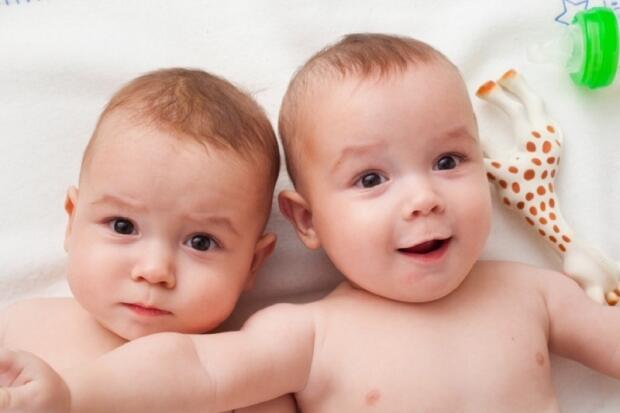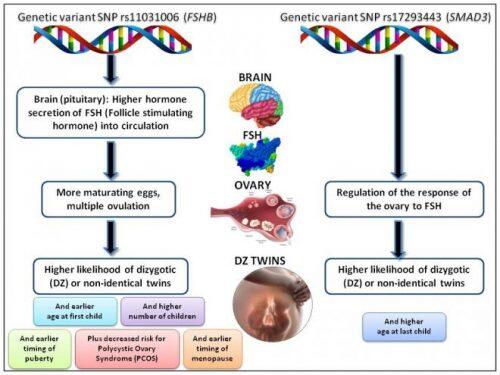Twins often run in families. Fraternal or non-identical twins, known to scientists as dizygotic (DZ) twins, occur when two different eggs are fertilized by two different sperm cells at the same time. Identical twins result when a single egg fertilized by a single sperm splits and forms two embryos. While identical twins occur around the world at a constant rate of 3 to 4 per every 1,000 births, DZ twinning varies considerably across the globe, from just 6 per 1,000 births in Asia to 40 per 1,000 births in Africa.
All signs point to some genetic basis for non-identical twins, yet the exact variants underlying this phenomenon have remained elusive… until now. A new Vrije Universiteit-led study isolates two genes linked to DZ twinning.
“We report the genetic variants associated with DZ twinning in European ancestry populations where the rate of DZ twinning is somewhere in between the rates in Asia and Africa,” Dr. Dorret Boomsma, lead author and a biological psychologist, and Dr. Hamdi Mbarek, co-author and a geneticist at VU Amsterdam, told Medical Daily. They explain the two variants are also present in both Asian and African populations. However, with different genetic backgrounds, these populations might carry additional variants that could not be isolated in this European ancestry study.
Will You Have Twins?
Rates of non-identical twinning varies by region, and have been known to change with time. In the United States, twin births increased by a factor of 1.9 between 1971 and 2009, due in part to more frequent use of fertility treatments. However, assisted reproductive technologies alone cannot explain all these twin births. In fact, in one year (2011) reproductive treatments resulted in just over a third of DZ twins. The majority had been conceived spontaneously.
Still, scientists do understand some factors that are likely to increase a woman’s chances of giving birth to twins. For example, women who are older mothers and women whose female relatives have given birth to fraternal twins are more likely to have them. For the current study, Boomsma, Mbarek, and an international team of researchers wanted to add to this pool of knowledge so they ventured to discover which genes contributed to the likelihood of non-identical twins.
They began by gathering genetic information from databases in the Netherlands, Australia, and the U.S. Next, the researchers identified 1,980 mothers of fraternal twins, all conceived without fertility treatments, and compared their data to a control group of 12,953 mothers who did not give birth to DZ twins. After searching for and isolating genetic variants shared by the mothers, the researchers sent their results to colleagues in Iceland, who sorted through their own cohort of 3,597 mothers with DZ twins and 297,348 controls.
“In genome wide association studies, it is very important to replicate the finding in an independent population,” the researchers explain. “This will validate the results.”
All told, the researchers found two variants which appeared more often in the mothers of fraternal twins than mothers who gave birth to a solo child.
One variant is associated with higher levels of follicle-stimulating hormone (FSH) in women while also playing a role in the reproductive capabilities in men. Follicle-stimulating hormones encourage a woman’s ovaries to release an egg. Higher FSH levels could cause multiple eggs to be released at the same time; if two become fertilized at once, this would result in non-identical twins.
The second genetic variant occurred in a gene called SMAD3, which is involved in cell signaling and, according to the researchers, likely plays a role in how a woman responds to FSH. If a woman’s ovaries are sensitive to FSH, then she may release multiple eggs even if her body produces only an average amount of the hormone.
The first genetic variant increases the relative odds of having twins by 18 percent, the researchers calculated, and the second by 9 percent. When combined, a woman’s odds of having DZ twins surged by 29 percent.
However, these two genetic variants are not the entire picture, say Boomsma and her colleagues. They believe more genes, not yet identified, play a part in the likelihood a woman will give birth to twins.
Source: Mbarek H, Steinberg S, Nyholt DR, et al. Identification of Common Genetic Variants Influencing Spontaneous Dizygotic Twinning and Female Fertility. The American Journal of Human Genetics. 2016.












